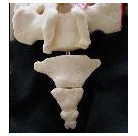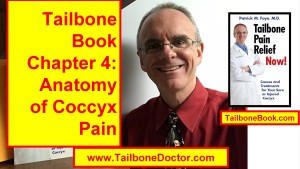Tailbone Book, Chapter 4: ANATOMY of Tailbone Pain, Coccyx Pain
- This is the next in a series of coccyx pain videos, giving you highlights from the chapters of Dr. Foye’s book, “Tailbone Pain Relief Now!”
The actual VIDEO is at the bottom of this page.
Here is the TEXT from the video:
- Hi. I’m Dr. Patrick Foye, M.D.
- I’m the Director of the Coccyx Pain Center or Tailbone Pain Center here in New Jersey in the United States and online at www.TailboneDoctor.com
- And this is the next in a series of videos reviewing the different chapters in my book “Tailbone Pain Relief Now!”
- In this video I’m reviewing Chapter 4 which is anatomy of the coccyx and anatomy of tailbone pain.
- And the idea here is that this chapter talks about the specific different bones in the coccyx, how you can differentiate some of those different bones from each other, how they’re different than other parts of the spine.
- The muscles and tendons and ligaments that attach to the tailbone are all listed and discussed within this chapter.
- Now this is really important because if you are suffering from a musculoskeletal condition it’s important that you understand a little bit about the anatomy of what’s causing your pain, what the normal structures are there, and what things can be abnormal.
- It’s also frankly important for your physicians to understand that anatomy, which unfortunately doesn’t always happen at the tailbone just because many doctors are not familiar with treating the tailbone.
- Anyway, so, within this chapter… so Chapter number 4 here, Anatomy of Tailbone Pain, as you can see from the illustration here (hopefully that will focus) you can see this is a view of the spine.
- So, there’s the cervical spine, the thoracic spine, the lumbar spine, the sacrum, and then down at the bottom is the coccyx or tailbone, right down here.
- And looking from the side view here again: the cervical spine (which is your neck region), the thoracic spine (which is where the ribs attach), the lumbar spine (very common for people to have lumbar back pain down where the belt line would be or the waistband would be in the lower back), and then down below that again is the sacrum and the coccyx.
- And each area of the spine is made up of a number of different bony segments.
- And that’s true at the tailbone as well.
- This is kind of getting a closer view here of the sacrum and coccyx.
- Again you can see the sacrum up here.
- And the tailbone or coccyx is down below.
- And then here from the side view is showing the same.
- And the book of course talks a lot more in depth about all of this.
- The one area that’s important to mention is the importance of language and how we talk about things.
- Because often it’s referred to as “the tailbone” or the coccyx, as if it is one singular bone, when really it’s not.
- The tailbone is actually a collection of bones.
- It’s anywhere from three to five bony segments that are… I’ll show you one here as well… so three to five bony segments that may or may not be fused together to different degrees in different patients.
- So the reason that’s really important in this section on anatomy is that doctors in the emergency room where you have your x-rays after your injury, or the radiologists reading it sometimes even they may see individual bony segments and sometimes erroneously think that that’s a fracture because it’s not a single bone.
- When really in most people it is not one single bone.
- It’s only a small percentage of people that have the entire tailbone fused together or fused together with the sacrum.
- Most people have some discrete bones.
- Some of them may be fused, some of them not.
- But that variability can really fool physicians as they’re looking at the imaging studies and they can sort of be mislead.
- So it’s important to recognize that although it’s called the tailbone, which sounds singular, it’s actually plural… it’s a series of bones that are there.
- The book also goes into how to distinguish some of the bones, particularly that first bone of the coccyx is different than most of the others in a couple of ways.
- Number one that first bone of the coccyx has what are called “cornua” which are “horns” that actually come up off of bone number one, which you can see a little bit of that here and here on this image.
- And bone number one also has parts that go out to the side… so it goes out right and left on each side, and those are the “transverse processes” which are where my fingers are touching here and here on this anatomic model.
- And you’ll notice that the rest of the bones down the tailbone really do *not* have those horns going up or those projections going out to the side.
- So that’s bone number one.
- I describe it as.. almost… in sports if you had the referee putting their hands straight up in American football for a “field goal”.
- Or in baseball putting a hands all the way out to the side on both sides for when a runner is “safe at the plate”.
- Those things are true at bone number one at the coccyx, but are not true of the rest.
- The rest of the chapter goes on to talk about the different anatomic attachments at the tailbone, specifying a number of the different ligaments that attach there: the anterior longitudinal ligament, the posterior sacrococcygeal ligament, sacrospinous ligaments, sacrotuberous ligaments, some of the nerves that are in the coccyx.
- All of that information is important to understand because any of those structures can be involved in causes of tailbone pain or in patients who have tailbone pain.
- So it’s important for hopefully your doctors and for yourself to understand some things about that.
- So there’s more details of course within the book.
- But this just gives you a glimpse of what is in Chapter 4 the “Anatomy of the Coccyx” or “Anatomy of Tailbone Pain”.
- For more information you can certainly find me online at www.TailboneDoctor.com if you are interested in coming for an evaluation or to find more educational information.
- If you want specifically a copy of the book the easiest way to get that is to go to www.TailboneBook.com.
- From there you can you can click for your appropriate country to get the best deal and the least amount of international shipping, to get either the paperback copy.
- Or you can just order the electronic copy of the book, the e-book, which you can which you can access from anywhere in the world that has internet access, you can click on that and download that in that way so it get an easiest place to find that is just go to www.TailboneBook.com
- Alright. I hope that information is helpful.
- If you have questions about the anatomy at the coccyx or comments about the anatomy at the coccyx or the structures that attach to it, post those down below the video.
- Post your questions and comments down below and I’ll be sure to be on the lookout for those and I’m sure others who watch this can read those and comment on those and learn from those as well.
- So, alright.
- That’s all for now.
- Bye, bye.
Here is the actual VIDEO:
Here is the screenshot thumbnail image for the video:
To get your copy of the book “Tailbone Pain Relief Now!” go to: www.TailboneBook.com
For more information on coccyx pain, or to be evaluated at Dr. Foye’s Tailbone Pain Center in the United States, go to: www.TailboneDoctor.com
Latest posts by Patrick Foye, M.D. (see all)
- Coccygectomy: Expected Recovery and Return to Work after surgery for coccyx pain, tailbone pain. - November 28, 2023
- PRP Platelet Rich Plasma or Prolotherapy for Tailbone Pain, Coccyx Pain - October 25, 2023
- Reasons for Normal X-rays and MRI Despite Tailbone Pain, Coccyx Pain - October 3, 2023


